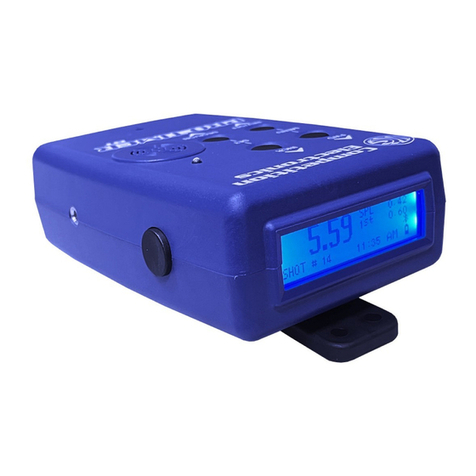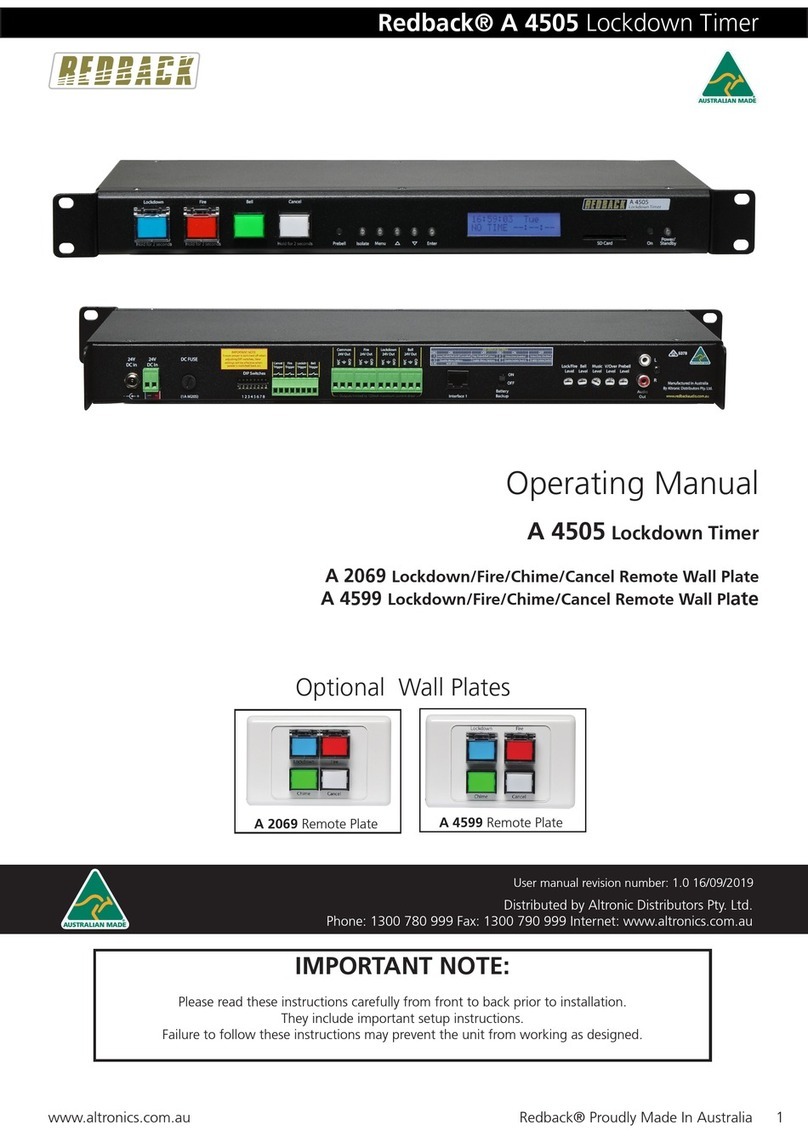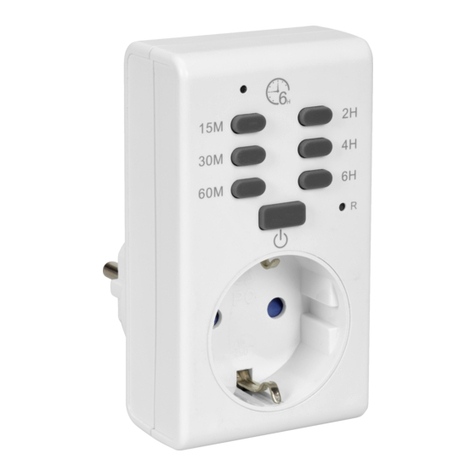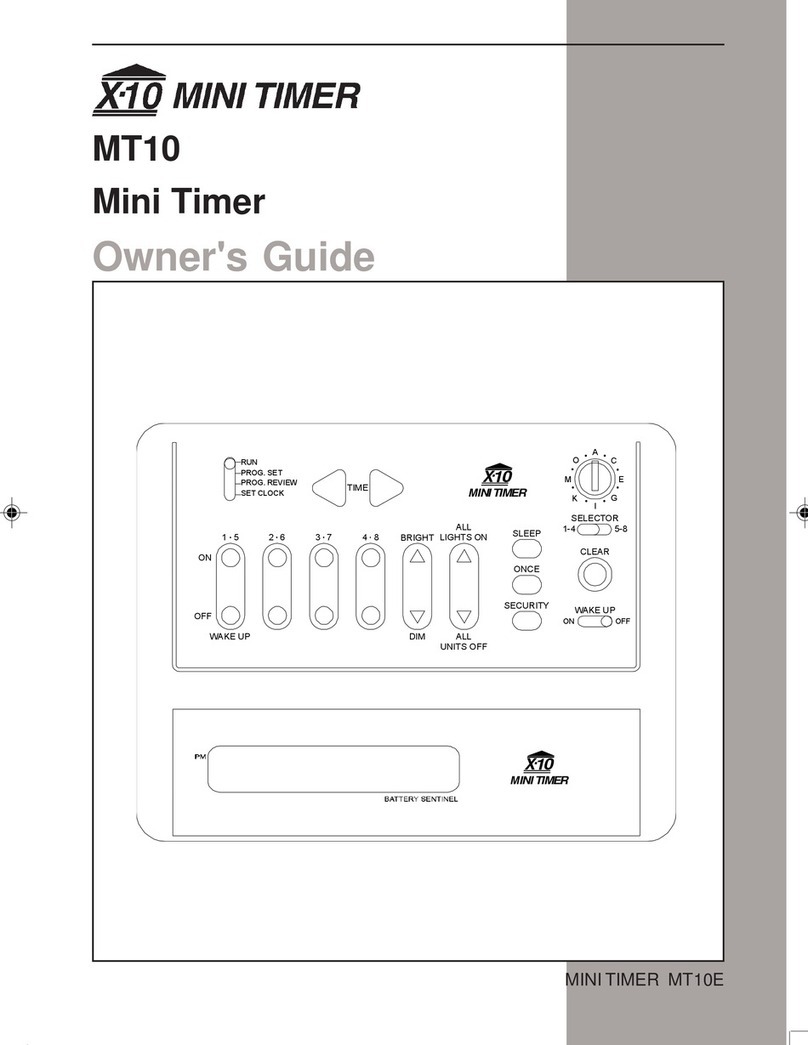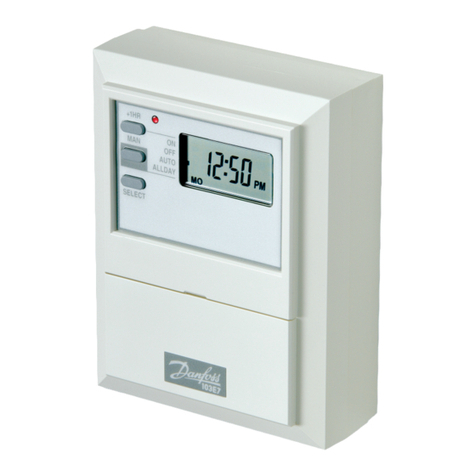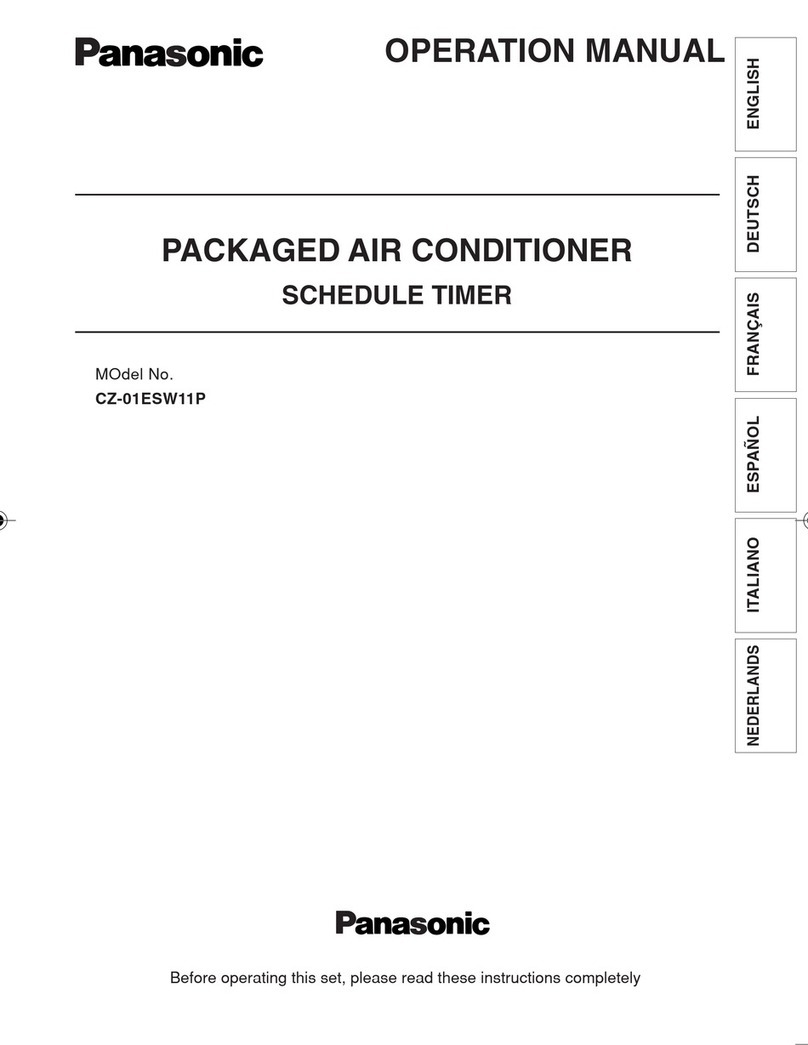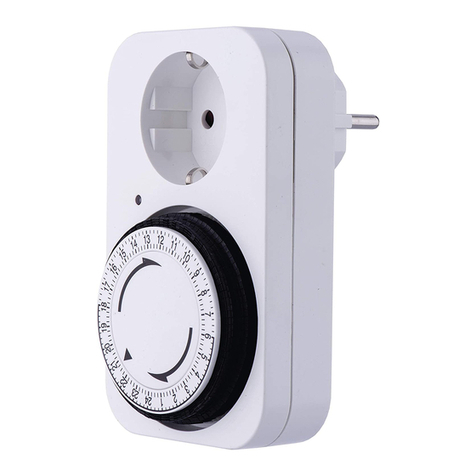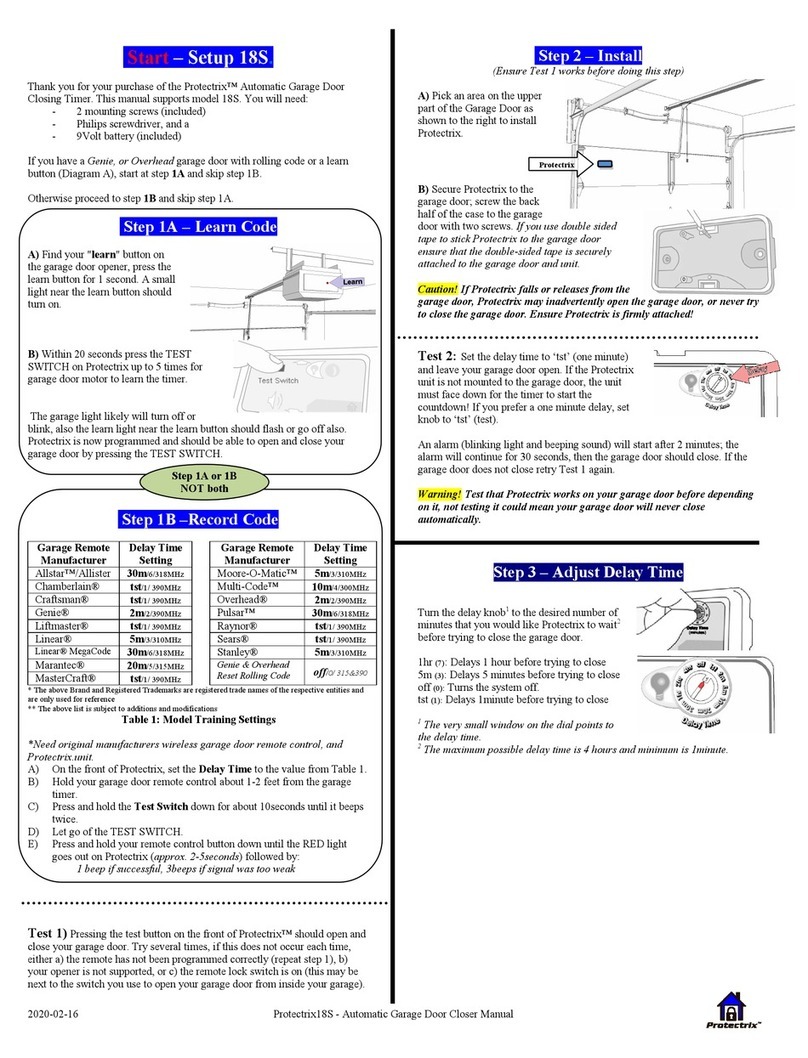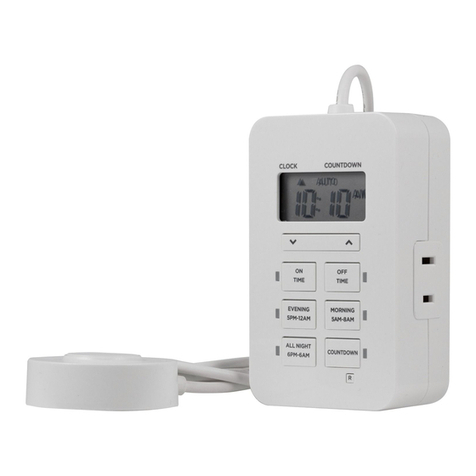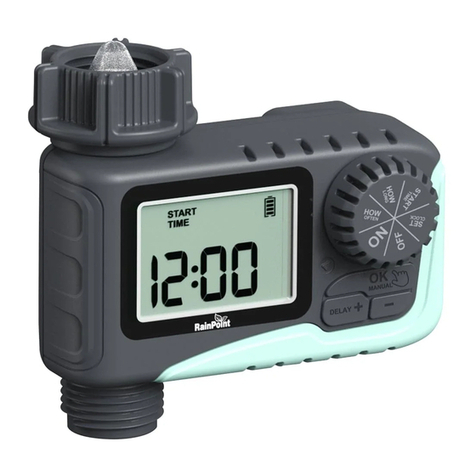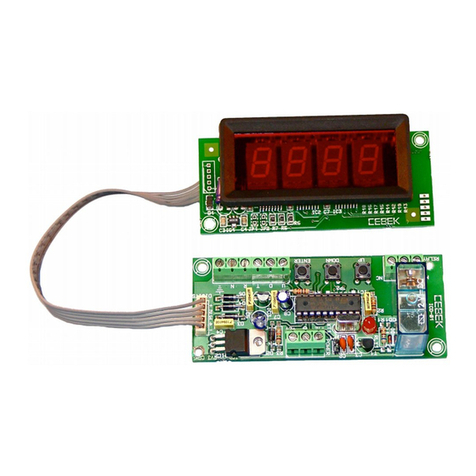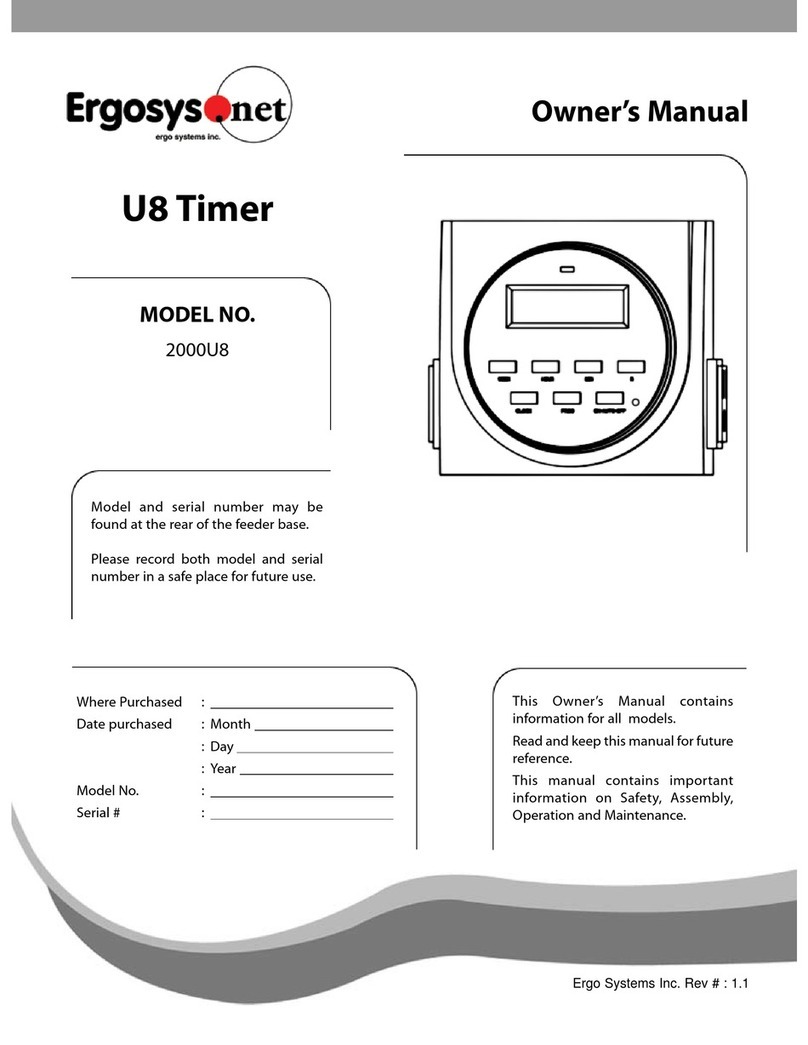Elimko E-FT-10 User manual

E-FT-10 USER MANUAL Elimko
1.1. TYPE CODING
1.2. TECHNICAL SPECIFICATION
1.3. DIMENSIONS
Page: 1/7
Operating Voltage
Display Type
Alarm Outputs
Retransmission Output
Relay Outputs
Control Type
Power Consumption
Operating Temperature
Storage Temperature
Memory
Weight
85-265 V AC / 85-375 V DC
20-60 V AC / 20-85 V DC
2x4 digit 10 mm 7 segment display
Relay: SPST-NO 250 V AC, 3 A
Current: 0-20 mA, 4-20 mA (isolated)
On/Off, Proportional(P)
7W (10 VA)
Minimum 8 Relays, maximum 128 Relays
SPST-NO 250 V AC, 1 A
Relay Mechanical Life
10 000 000 operation
Relay Electrical Life Almost same as mechanical life, because
the switching is made with semiconductor.
0 C, +55 C
(With no condensation or icing)
°°
-25 C, +55 C
(With no condensation or icing)
°°
EEPROM max. 10000 writing
400 g
E - FT - 10 - T - U - V - W - X - Y - Z
Operating Voltage
0: 85-265 VAC / 85-375 VDC
1: 20-60 VAC / 20-85 VDC
Communication
0: None 1: RS-485
Analog Output
0: None
1: 1 Analog Output
Number of Output
8: 8 relays
16: 16 relays
24: 24 relays
32: 32 relays
40: 40 relays
48: 48 relays
56: 56 relays
64: 64 relays
72: 72 relays
80: 80 relays
88: 88 relays
96: 96 relays
104: 104 relays
112: 112 relays
120: 120 relays
128: 128 relays
Pressure Control (1)
0: None
1: Pressure Sensor
The package of E-FT-10 device contains;
Device
User manual
Guarantee certificate
m
After opening the package, please check the contents with the above list. If the delivered product is wrong type, any item is missing or
there are visible defects, contact the vendor from which you purchased the product.
m
Before installing and operating the device, please read the user manual thoroughly.
m
The installation and configuration of the controller must only be performed by a person qualified in instrumentation.
m
Keep the unit away from feamable gases, that could cause explosion.
m
Do not use alcohol or other solvents to clean the device. Use a clean cloth soaked in water tightly squeezed to gently wipe the outer
surface of the device.
m
E-FT-10 device control units are designed for rail mounting and should be used in an industrial environment.
The lifetime of device is 10 years.
m
90 mm
105 mm
FT-10
Elimko
158 mm
90 mm
PRG
Elimko
FT-10
P
LO HI
8888
8888
RL1 RL2 PR ENTER
OUT
90 mm
68 mm
45 mm
34 mm
49 mm
58 mm
2: Analog Input(Current, Voltage)
(1) Pressure sensor of device works in 7kPa range. If pressure control is
selected as analog input, input type and input range must be defined on
order.
±
E-FT-10 is a programmable timer which has pressure control unit,
is used in filter cleaning system. Device contains a control unit and
output units, that are controlled by control unit. Control unit
controls the output units on communication line. Operating and
selonoid voltages of output units are supplied from control unit.
Control unit has 8 outputs, each output unit has up to 16 outputs.
Outputs can switch maximum 250 VAC, 1A. Device has 2 alarm
relays. These relays can give an alarm to user, if any problem
exists on output selonoids. RS-485 communication line on the
device works according to Modbus protocol. Configuration
parameters and error messages can also be viewed using Modbus.
Outputs scanning order is configured by comminucation line.
Device has 2 different kind of pressure input according to device
type code, that is explained in . If U (TYPE
CODING) is selected as “1”, pressure inputs are connected
on quick connect, that is shown as LO and HI on the front panel.
In this case, differential pressure is measured by internal pressure
sensor. If U (TYPE CODING) is selected as “2”, an analog signal
(current or voltage) is connected to analog input of device. In
these two different situation, pressure value is shown on display,
retransmitted on analog output. Device can perform ON/OFF or
proportional control according to pressure value. These control
methods are explained in .
1.1 TYPE CODING
4.1 CONTROL TYPES
PRG
Elimko
FT-10
P
LO HI
8888
8888
RL1 RL2 PR ENTER
OUT
Figure 1.1 FT-10 Front Panel
1. INTRODUCTION
Selonoid Voltage
0: None
1: Yes
(220 VAC, 24 VAC, 24 VDC) (2)
Panel
0: None 1: Panel
(2) When X is selected as “1” (Solenoid Voltage Yes) than Y must be selected
as “1”.
When X is selected as “1” factory default is 24 VDC.
KY-FT10-0423-1

E-FT-10 USER MANUAL Elimko
FT-10
B
12345678910 11 12 13 14 15 16 17 18
VIN
-
-
-
-
CC
CC
O14
O15
O16
O13
O9
O10
O11
O12
A
O6
O7
O8
O5
O1
O2
O3
O4
12345678910 11 12 13 14 15 16 17 18
CC
CC
VSUP
--
-
-
DATA
Elimko
Output Units
Power Supply
Output Units
Data Line
Selonoid
Supply
Selonoid
Terminals
Selonoid
Terminals
2.2. OUTPUT UNIT CONNECTION DIAGRAM
Before operating the device, ensure that the device is
correctly configured. Incorrect configuration could result
malfunction.
m
Control Unit A1-A3, B9-B28, output unit A7-A18, B5-B18
terminals have dangerous voltage. While device is powered,
never touch to these terminals.
m
2. CONNECTION DIAGRAMS
B
12345678910 11 12 13 14 15 16 17 18 19 20 21 22 23 24 25 26 27 28
L
N
IN1 IN2 INC+
GND
TRXA
TRXB A.OUT
--
-
VSUP
-
-
-
DATA
A
85-265 V AC/85-375 V DC
20-60 V AC/20-85 V DC
m
m
m
m
2.1. CONTROL UNIT CONNECTION DIAGRAM
Elimko
1
FT-10
Alarm1 and Alarm2 give alarm according to different alarm
source, that is explained .4.2 ALARM RELAYS
A21 and A22 (+VSUP-) terminals are power supply of output
units and are connected to A2 and A3 terminals of output
units. A23 (DATA) terminal is data line of output units, and
are connected to A1 terminal of output units. These
terminals must be connected in order to power output units.
Selonoids supply voltage must be connected B9 and B10
(+VSIN-) terminals.
B11 and B12 (-VOUT+) terminals must be connected to
B5 and B6 (+VIN-) terminals of output units for selonoid
supply voltage on output units. If these terminals are not
connected, all of selonoids on output units are open circuit,
so device gives alarm and selonoids are not powered.
-
2
Output Units
Selonoid Supply
AIN
-
V
3
-
-
-
-
4
Selonoid
Supply
5678
-
-
9
VSIN
10
--
11
VOUT
8888
8888
RL1
12
-
-
Output Units
Power Supply
13
O1
RL2
RS-485
Communication
Line
14
C
15
O2
16
O3
OUT
17
C
Selonoid
Terminals
18
O4
PR
19
O5
20
C
21
O6
22
O7
23
C
24
O8
25
PRG
ENTER
Start
Input
RL1
Output Units
Data Line
26 27
RL2
28
Alarm1
Alarm2
Analog
Output
E-FT-10 front panel image is shown in part.
led lights when Relay1 (RL1) is powered, led lights when Relay2
(RL2) is powered, led lights when any selonoid output is powered,
and led lights during configuration mode.
During normal operation page, active group number (XX) is shown on
the top display like as ( XX), and active output number (YYY) is
shown on the bottom display like as ( YYY).
During normal operation page, button is used for displaying
differential pressure and set values and changing set values. While
and parameters are shown, and buttons change
the set values and button reverts to the normal operation page.
During normal operation page, if and buttons are pressed together,
error message display is opened. During error message display,
button is used for scanning outputs that have an error,
button reverts to the normal operation page.
Except the normal operation page, if any button isn’t pressed for more
than 25 seconds, device reverts to normal operation page automatically.
Configuration page is opened to configure other parameters of device.
1.INTRODUCTION RL1
RL2
OUT
PR
Gr
O
ENTER
SETL SETH
PRG
ENTER PRG
Pressing button for more over 2 seconds enters the configuration
page.
PRG
When the configuration page is entered, message is shown
on the top display and is shown on the bottom display. Security
code must be entered correctly to configure the parameters. If the
security code is entered incorrectly, parameters are showned, but
parameters can not be changed.
COD
0
While in configuration pages, button selects parameters,
and buttons change the value of parameters, button is
pressed for more over 1 second for revert to configuration pages
display, button reverts to normal operation page.
ENTER
ENTER
PRG
GR01
O 1
Factory setting of the security code is “10”. The security code can
be changed with parameter. If the security code is forgotten,
repower the device and pressing , and buttons together
with in 1 minute after start up. After that security code control isn’t
made one time to enter configuration page, so the security code can
be changed with parameter.
SCOD
ENTER
SCOD
During configuration pages, and buttons select pages,
button enters to the selected page, button reverts to normal
operation page.
ENTER
PRG
NOTE : Error Message Display (see )3.2 DISPLAY FIGURES
PRG
When the security code is entered correctly, pressing button
enters the configuration pages.
ENTER
O 16
Shrt
ENTER
O 4
Open
ENTER
GR01
O 1
NO
ERR
GR01
O 1
PRG
High
Prss
During None Alarm
During Alarm
ENTER
Volt
3. USAGE
NoGR01
O 1
q
q
q
q
q
q
Page: 2/7
KY-FT10-0423-1

Elimko
3.1. PARAMETERS EXPLANATIONS
MAR :
INS :
HYS :
R1TP:
R1FN:
R1KB:
R2TP:
R2FN:
R2KB:
TA :
TP :
TG :
TB :
NOUT:
NGRP:
Analog output retransmission current range. Parameter can be set , , , .0-20 20-0 4-20 20-4
Differential pressure offset value. According to that paramater, differential pressure value
has positiveor negative offset. Parameter can be set between -1999 and 9999.
Hysterisis value of differential pressure alarm set value ( ). Parameter can be set
between 0 and 9999.
ASP
Alarm type of RL1 alarm relay. Parameter can be set or .(see Table 4)NO NC
Alarm function of RL1 alarm relay. Parameter can be set between 0 and 15.
(see 4.2 ALARM RELAYS)
When is selected , in case of an alarm, user must acknowledge the alarm by
pressing and buttons in order to deactivate alarm output. Parameter can be set
or .
R1KB ON
ON
OFF
Alarm type of RL2 alarm relay. Parameter can be set or .(see Table 4)NO NC
Alarm function of RL2 alarm relay. Parameter can be set between 0 and 15.
(see 4.2 ALARM RELAYS)
Selonoid outputs break time. This parameter determines the break time between two
outputs. Parameter can be set between 0.1 and 999.9 in seconds.
Selonoid outputs pulse time. This parameter determines the pulse time of each outputs.
Parameter can be set between 0.1 and 100.0 in seconds.
Selonoid outputs group break time. While parameter is higher than “1”, this
parameter determines the break time between each group. Parameter can be set
between 0.1 and 999.9 in seconds.
Ngrp
Selonoid outputs waiting time. This parameter determines waiting time, after all outputs
are powered. Parameter can be set between 0.1 and 999.9 in seconds.
Number of outputs. This parameter determines the number of outputs. Parameter can
be set between 1 and 128.
Number of groups. This parameter determines number of groups while filtering is done
with different groups. Parameter can be set between 1 and 16. If this parameter set “1”,
filtering is done only one group.
COD :
Parameters of PageGcnf
CTYP:
DP :
RTLL:
RTHL:
SETL:
SETH:
ASP :
PRSS:
Security code value for setting parameters. Security code enters between 0 and 9999.
Control Type. Parameter can set , or . (Refer to 4.1. CONTROL TYPESNone Onof prop )
Decimal point of differential pressure. Parameter can be set between 0 and 3.
Analog output retransmission low level. Parameter can be set between -1999 and 9999.
Analog output retransmission high level. Parameter can be set between -1999 and 9999.
Differential pressure value low set value. Parameter can be set between -1999 and .SETH
Differential pressure value high set value. Parameter can be set between and 9999.Setl
Differential pressure value alarm set value. Parameter can be set between -1999 and 9999.
Differential pressure value.
NTUR:
OUTL:
Number of selonoids scanning after deactivation of start input. Parameter can be set
between 0 and 50.
Low limit of internal impedance of selonoids. If the impedance measurement of
selonoids are lower than that value, device gives a short circuit alarm. Parameter can
be set between 0.00 k and If this parameter set to “0" the device dosen’t control
short circuit.
WOuth.
E-FT-10 USER MANUAL
When is selected , in case of an alarm, user must acknowledge the alarm by
pressing and buttons in order to deactivate alarm output.Parameter can be set
or .
R2KB ON
ON
OFF
ADRS:
BAUD:
PRTY:
OUTH:
TATP:
Communication address. Parameter can be set between 1 and 127. All device in same
communication line should have an unique address.
Communication baud rate. Parameter can be set , , or kBaud. Baud rate
of all devices in same communication line should be the same as baud rate of master
device.
4.8 9.6 19.2 38.4
Communication parity. Parameter can be set , or . Parity of all devices in
same communication line should be the same as parity of master device.
NONE ODD EVEN
High limit of internal impedance of selonoids. If the impedance measurement of
selonoids are higher than that value, device gives an open circuit alarm. Parameter can
be set between and 30.00 kOutL .W
When is selected as , faulty selonoids are skipped immediately, and whenTATP Off
TATP On ON OFFis selected as , all the timings work as usual. Parameter can be set or .
Parameters of Pageclbr
ZRCL:
FLTR:
ZERO:
Filter value of differential pressure value. This parameter determines the number of
samples to be averaged for calculation of differential pressure value. Parameter can be
set between 1 and 16.
This parameter determines pressure value of low calibration of pressure input.
Parameter can be set between -1999 and 9999.
Zero calibration value of differential pressure. This parameter isn’t advised to change.
ZERO value differential pressure is applied to differential pressure input of device.
and buttons press together, in order to save value.
OLCR: 0 Ohm calibration value of selenoid resistance measurument. This parameter isn’t
advised to change. Selonoid supply voltage that is connected to B9 and B10 terminals
is broken. B11 and B12 terminals are done short-circuit and buttons press
together in order to save value.
OHCR: 1000 Ohm calibration value of selonoid resistance measurument. This parameter isn’t
advised to change. Selonoid supply voltage that is connected to B9 and B10 terminals
is broken. 1000 ohm resistance is connected to B11 and B12 terminals. and
buttons press together in order to save value.
Page: 3/7
GTIP: Type of group operation. Parameter can be selected and .TIP1 TIP2
(
Şifrenin yanlış girilmesi halinde
parametreler görüntülenir fakat
ayarlanamaz
)
TA
1.0
TP
1.0
TG
1.0
TB
10.0
ENTER
PRG
PRG
PRG
PRG
ENTER
ENTER
ENTER
PRG
PRG
PRG
PRG
PRG
PRG
PRG
PRG
PRG
PRG
PRG
PRG
PRG
PRG
PRG
PRG
PRG
PRG
PRG
PRG
PRG
PRG
PRG
PRG
Sayfa Başına
Gr01
O 1
COD
PAGE
GCNF
CTYP
ONOF
DP
RTLL
RTHL
9999
MAR
4-20
INS
HYS
NOUT
NGRP
GTIP
OUTL
OUTH
20.00
TATP
BAUD
PRTY
ADRS
R1tp
R1fn
R1kb
R2tp
R2fn
R2kb
0.02
ODD
0
0
0
0
10
ENTER
ENTER
ENTER
ENTER
ENTER
ENTER
ENTER
ENTER
ENTER
PRG
8
1
TIP1
ENTER
ENTER
ENTER
ENTER
ENTER
ON
9.6
1
ENTER
ENTER
ENTER
ENTER
No
0
On
No
0
ENTER
ENTER
ENTER
ENTER
ENTER
On
ENTER
ENTER
(2 sn)
PRSS
Sayfa Başına
PRG
0
PAGE
CLBR
SPAN
ZRCL
ZERO
AOL
1000
Spcl
FLTR
SCOD
AOH
7000
500
60
600
10
0
1
ENTER
ENTER
ENTER
ENTER
ENTER
ENTER
ENTER
ENTER
ENTER
ENTER
PRG
PRG
PRG
PRG
PRG
PRG
PRG
PRG
SETL
PRG
0
ENTER
1000
SETH
PRG
ENTER
ASP
500
PRG
ENTER
OHCR
OLCR
2000
-35
ENTER
ENTER
PRG
PRG
PAGE
OCNF
ENTER
PRG
OC 6
OC 5
OC 4
OC 8
O16
OC 7
OC 1
OC 9
O16
O16
O16
O16
O16
O16
ENTER
ENTER
ENTER
ENTER
ENTER
ENTER
ENTER
PRG
PRG
PRG
PRG
PRG
PRG
PRG
OC 3
OC 2
O16
O16
ENTER
ENTER
PRG
PRG
OC12
OC11
OC10
OC14
O16
OC13
OC15
O16
O16
O16
O16
O16
ENTER
ENTER
ENTER
ENTER
ENTER
ENTER
PRG
PRG
PRG
PRG
PRG
PRG
PRG
Sayfa Başına
PRG
NTUR
3
ENTER
KY-FT10-0423-1

E-FT-10 USER MANUAL Elimko
3.2. DISPLAY FIGURES
4. WORKING PRINCIPLES
When parameter is equal to “1”, Starting of scanning
selonoids, device waits for break time, after that O1 output is
activated. This output is active for pulse time, after that O1
output is deactivated. Device waits break time and same
process repeats with the next selonoid. This process continues
until number of outputs reach to parameter. When last output
is deactivated at the end of pulse time, device starts to
waiting time. After waiting that time, break time is started and
O1 output is activated at the end of break time and repeats
same process.
NGRP
TA
TP
TA
NOUT
TP TB
TA
TA
Gr01
O 15
Gr03
O 8
----
----
Stop
----
Gr03
----
Normal Operating Display
1. Group 15. Output
3. Group 8. Output
3. Group Break Time
Waiting Time
Wait Start Input
No
Volt
O 2
Shrt
O 13
Open
High
Prss
No
Err
Error Messages Display
No Selonoid Voltage
Selonoid on Output 2
Short Circuit
Selonoid on Output 13
Open Circuit
High Pressure Alarm
No Alarm
If start input of device is active, this process continues. After
deactivation of start input, the device repeats this process for
times and stop the process.
First of 8 outputs is used on the control unit. Output units must be
used for more than 8 outputs.
NTUR
ta
0
0
0
tp
tb
OUT1
OUT2
OUT3
OUT4
OUT5
Figure 4.1: Working diagram ( = 1, = 5)NGRP NOUT
When the parameter is set to , the device works as shown in
. When scanning starts, O1 output of group card is energized
and 1st Group is selected. break time is started. O1 output of the
device is energized at the end of the break time period and the pulse
time is started. At the end of the pulse time period, O1 is de-energized
and break time is started again and the same operation is repeated
until the number of output reaches the value of parameter. When
the last output is de-energized, O1 output of the group card is
de-energized togetherly. group waiting time is started. At the end of
the group waiting time period, the O2 output of the group card is
energized and the 2nd Group is selected. The operations in the 1st
group are repeated exactly. this group operations is repeated until the
number of group reaches the value of parameter. At the end of
the last group operation, waiting time period starts. After the waiting
time period, 1st group is selected again and same operations are
repeated.
GTIP TIP1
Figure 4.2
TA
TP
TA
NOUT
TG
NGRP
TB
If start input of device is active, this process continues. After deactivation
of start input, device repeats this process for times and stop the
process.
First of 8 outputs is used on control unit. Output units must be used for
more than 8 outputs.
One output unit is used to group selection unit. Selonoid supply of group
selection unit (+VIN-) is connected to control unit (+VSIN-) terminal.
NTUR
ta
0
0
0
tp
tg
GRUP1
GRUP2
OUT1
OUT2
OUT3
tb
Figure 4.2: Working Diagram ( = 2, = 3 and = )NGRP NOUT GTIP TIP1
AOL :
AOH :
SCOD: Security code.
Analog output 4 mA calibration value. This parameter isn’t
advised to change. Connect an ampermeter A27(-) and
A28(+) terminals. While the parameter is selected, adjust
the parameter with and buttons value until the meter
reading is equal to 4 mA.
Analog output 20 mA calibration value. This parameter isn’t
advised to change. Connect an ampermeter A27(-) and
A28(+) terminals. While the parameter is selected, adjust
the parameter with and buttons value until the meter
reading is equal to 20 mA.
Parameters of Pageclbr (continuation)
Page: 4/7
SPAN:
SPCL:
This parameter determines pressure value of high
calibration of pressure input. Parameter can be set between
-1999 and 9999.
Span calibration value of differential pressure. This
parameter isn’t advised to change. value differential
pressure is applied to differential pressure input of device.
and buttons press together, in order to save value.
SPAN
Parameters of PageOCNF
The parameters between and are used to determine
the count of output on the connected output cards. The output
cards are produced 8 or 16 outputs in manufacturing period. These
parameters are used to define the count of outputs to device.
These parameters are set to or .
OC 1 OC15
O8 O16
In case the device parameter is greater than 1, 2 different
operating type is available. This operating type is determined by
the parameter. In applications where the number of groups
is greater than 1, the group 1 output card is used as the selection
card.
NGRP
GTIP
When the parameter is set to , the device works as shown in
. When scanning starts, O1 output of group card is energized
and 1st group is selected. break time is started. O1 output of the
device is energized at the end of the break time period and the pulse
time is started. At the end of the pulse time period, O1 is de-energized
and break time is started again and the same operation is repeated
until the number of output reaches the value of parameter. When
the last output is de-energized, O1 output of the group card is
de-energized togetherly. group waiting time is started. At the end of
the group waiting time period, the O2 output of the group card is
energized and the 2nd group is selected. The outputs of 2nd group
starts from where the last output of 1st group, and scanning operation
is repeated until the number of output reaches the value of
parameter. As seen in the example, the last output of 1st group is
energized O3 output, and the first output of 2nd group is energized O4
output. This group operations is repeated until the number of group
reaches the value of parameter. At the end of the last group
operation, waiting time period starts. After the waiting time period,
1st group is selected again and same operations are repeated.
GTIP TIP1
Figure 4.3
TA
TP
TA
NOUT
TG
NOUT
NGRP
TB
ta
0
0
0
tp
tg
GRUP1
GRUP2
OUT1
OUT2
OUT3
tb
OUT4
OUT5
OUT6
Figure 4.3: Working Diagram ( = 2, = 3 and = )NGRP NOUT GTIP TIP2
KY-FT10-0423-1

Elimko
E-FT-10 USER MANUAL
Page: 5/7
Rl1 and RL2 are alarm relays, that give alarm according to one
or more than one alarm source. Alarm type of these relays are
adjusted as normally open or normally closed.
Device gives alarm in case of break selonoid supply, open or
short selonoids and high differential pressure value. These alarm
sources are adjusted for both of the relays with and
parameters, like as . Alarm types of relays, that is
normally open and normally closed are adjusted for both of the
relays with and parameters, like as .
When alarm relays are powered, user can acknowledge the alarm
and deactivate the alarm relay according to and
parameters. If these parameters are selected , user open error
message page and deactivates relay, but led of relay continues to
light. In this situation, error message of alarm is shown in error
message page. Led of relay fades after alarm state. If these
parameters are selected , relay and led deactivates after the
alarm state ends.
R1FN R2FN
Table 4.2 NO
NC
R1TP R2TP Table 4.1
R1KB R2KB
ON
OFF
4.2. ALARM RELAYS
1
0
ALARM
NC (Normally Closed)
Table 4.1. Alarm Types
RTPX
1
0
ALARM
NO (Normally Open)
Device can give alarm, while short or open circuit happen on
selonids. Device measures the selonoid line and controls any
error on the selonoid line, before device powers the selonoids.
If any error is occured on selonoid, device doesn’t power the
selonoid and gives alarm, so that outputs of device don’t need
any fuses. In the selonoids scanning, while the selonoid has any
problem, device works differently according to parameter.
If parameter is selected , device waits and timing for that
selonoid, but output doesn’t powered. If the parameter is selected
, device doesn’t wait and timing, and continues next
output. parameter determines open circuit state,
parameter determines short circuit state. parameter should
be set to half of the nominal resistance of the selonoids,
parameter should be set to two times of the nominal resistance of
the selonoids.
TATP
ON TA TP
OFF TA TP
OUTH OUTL
OUTL
OUTH
Device, that has pressure control gives high pressure alarm
according to and parameters. If differential pressure is
higher than parameter, device gives high pressure alarm. The
alarm condition ends when the differential pressure reading
decrease to - .
ASP HYS
ASP
ASP HYS
4.2.1. OPEN / SHORT CIRCUIT ALARM
4.2.2. HIGH PRESSURE ALARM
Table 4.2. Alarm Sources
No Alarm
OC
SC
SC / OC
HP
HP / SC
HP / OC
HP / OC / SC
NSS
NSS / OC
NSS / SC
NSS / OC / SC
NSS / HP
NSS / HP / SC
NSS / HP / OC
NSS / HP / OC/ SC
SA
SA / OC
SA / SC
SA / OC / SC
SA / HP
SA / HP / SC
SA / HP / OC
SA / HP / OC / SC
SA / NSS
SA / NSS / OC
SA / NSS / SC
SA / NSS / OC / SC
SA / NSS / HP
SA / NSS / HP / SC
SA / NSS / HP / OC
SA / NSS / HP / OC / SC
RFNXExplanations
0
1
2
3
4
5
6
7
8
9
10
11
12
13
14
15
16
17
18
19
20
21
22
23
24
25
26
27
28
29
30
31
(SC: Short Circuit,
OC: Open Circuit,
HP: High Pressure,
NSS: No Selonoid Supply,
SA: Scan Active)
RFNXExplanations
(SC: Short Circuit,
OC: Open Circuit,
HP: High Pressure,
NSS: No Selonoid Supply,
SA: Scan Active)
CTYP parameter determines control type of the device, is selected
as , or .
If parameter is selected as , device doesn’t do any
control during waiting times. Entire of waiting time is waited.
NONE ONOF PROP
CTYP NONE
TB TB
4.1. CONTROL TYPES
If parameter is selected as , if differential pressure
value is higher than parameter, waiting time is skipped
during the process. If differential pressure value is lower than
parameter, Entire of waiting time is waited during the process.
If differential pressure value is between and parameters,
CTYP prop
SETH TB
SETL
TB
SETL SETH
TB TBwaiting time is set between 0 and proportionally.
If parameter is selected as if differential pressure value
is higher than parameter, waiting time is skipped during
the process. If differential pressure value is lower than
parameter, Entire of waiting time is waited during the process.
If differential pressure value is between and parameters,
device does the same as previous scanning.
CTYP ONof,
SETH TB
SETL
TB
SETL SETH
SetL
Tb
0SetH
SetL
Tb
0SetH
4.2.3. NO SELONOID SUPPLY ALARM
If Selonoid supply of device, that is connected (+VSIN-) terminals
is broken, device gives no selonoid supply alarm.
4.2.4. SCAN ACTIVE ALARM
When Start input of device that is in A24 (IN1) terminal is active,
the device gives scan active alarm.
All of these alarms is shown on display to user. In addition, if device
has RS-485 communication, the alarms can be read from Modbus
protocol.
KY-FT10-0423-1

Elimko
E-FT-10 USER MANUAL
Each output unit has 16 outputs. Output units communicate with
control unit over DATA terminal. If this connection breaks, output
unit doesn’t work. Power supply of output units are supplied with
(+VSUP-) terminals. Each output unit, that is connected to control
unit has an address. These adresses are configured via jumpers
on output unit cards. More than one unit mustn’t have same
adresses. Jumper configuration of addresses are shown in
.
(+VIN-) terminals of output units must be connected to (-VOUT+)
terminals of control unit. If any problem on that connection occurs,
all of the selonoids are measured open circuit and any output isn’t
powered. If filtering system has more than one group, one output
unit must be used for group selction unit. Selonoid supply of this
unit must be connected (+VSIN-) terminals of control unit.
Table 5.1
Table 5.1. Configurations of Jumper
5. OUTPUT UNITS
Page: 6/7
Jumper
1234
1234
1234
1234
1234
1234
1234
1234 1234
Explanations
1. Output Card
3. Output Card
2. Output Card
4. Output Card
5. Output Card
6. Output Card
7. Output Card
8. Çıkış Kartı Group Selection Card
Jumper Explanations
1234
1234
1234
1234
1234
1234
1234
9. Output Card
11. Output Card
10. Output Card
12. Output Card
13. Output Card
14. Output Card
15. Output Card
Address
100
101
102
103
104
105
106
107
108
109
110
111
112
113
114
115
116
117
118
119
120
121
122
123
124
125
126
127
128
129
130
131
Parameter
OUT 11-12
OUT 13-14
OUT 15-16
OUT 17-18
OUT 19-20
OUT 21-22
OUT 23-24
OUT 25-26
OUT 27-28
OUT 29-30
OUT 31-32
OUT 33-34
OUT 35-36
OUT 37-38
OUT 39-40
OUT 41-42
OUT 43-44
OUT 45-46
OUT 47-48
OUT 49-50
OUT 51-52
OUT 53-54
OUT 55-56
OUT 57-58
OUT 59-60
OUT 61-62
OUT 63-64
OUT 9-10
OUT 1-2
OUT 3-4
OUT 5-6
OUT 7-8
Property
R/W
R/W
R/W
R/W
R/W
R/W
R/W
R/W
R/W
R/W
R/W
R/W
R/W
R/W
R/W
R/W
R/W
R/W
R/W
R/W
R/W
R/W
R/W
R/W
R/W
R/W
R/W
R/W
R/W
R/W
R/W
R/W
Address
132
133
134
135
136
137
138
139
140
141
142
143
144
145
146
147
148
149
150
151
152
153
154
155
156
157
158
159
160
161
162
163
Parameter
OUT 101-102
OUT 103-104
OUT 105-106
OUT 107-108
OUT 109-110
OUT 111-112
OUT 113-114
OUT 115-116
OUT 117-118
OUT 119-120
OUT 121-122
OUT 123-124
OUT 125-126
OUT 127-128
OUT 65-66
OUT 67-68
OUT 69-70
OUT 71-72
OUT 73-74
OUT 75-76
OUT 77-78
OUT 79-80
OUT 81-82
OUT 83-84
OUT 85-86
OUT 87-88
OUT 89-90
OUT 91-92
OUT 93-94
OUT 95-96
OUT 97-98
OUT 99-100
Property
R/W
R/W
R/W
R/W
R/W
R/W
R/W
R/W
R/W
R/W
R/W
R/W
R/W
R/W
R/W
R/W
R/W
R/W
R/W
R/W
R/W
R/W
R/W
R/W
R/W
R/W
R/W
R/W
R/W
R/W
R/W
R/W
Scanning order of the device starts with 1, and ends with 128 in
factory settings. The scanning order can be configured using
Modbus protocol. Register addresses of these order parameters
are shown in .Table 4.3
4.3. SCANNING ORDER OF OUTPUTS
Tablo 4.3. Output Configuration Parameters Modbus
Address Table
NOTE1: Parameters, that shown in Table 4.3 are 16-bits. For
example low 8-bits of OUT1-2 parameter shows first output, high
8-bit of OUT1-2 parameter shows second output. In below
example, output 5 is powered firstly, output3 is powered secondly
according to OUT1-2 parameter. Other parameters are configured
the same method.
OUT1-2 = 773
ilk 8-bit = 5son 8-bit = 3
NOTE2: Low and High 8-bits of parameters must be set between
1 and 128. Otherwise, sent values of these parameters aren’t
saved according to protocol.
KY-FT10-0423-1

O1O2O3O4O5O6O7O8Alarm Data 1
O9O10O11O12O13O14O15O16Alarm Data 2
O17O18O19O20O21O22O23O24Alarm Data 3
O25O26O27O28O29O30O31O32Alarm Data 4
O33O34O35O36O37O38O39O40Alarm Data 5
O41O42O43O44O45O46O47O48Alarm Data 6
O49O50O51O52O53O54O55O56Alarm Data 7
O57O58O59O60O61O62O63O64Alarm Data 8
O65O66O67O68O69O70O71O72Alarm Data 9
O73O74O75O76O77O78O79O80Alarm Data 10
O81O82O83O84O85O86O87O88Alarm Data 11
O89O90O91O92O93O94O95O96Alarm Data 12
O97O98O99O100O101O102O103O104Alarm Data 13
O105O106O107O108O109O110O111O112Alarm Data 14
O113O114O115O116O117O118O119O120Alarm Data 15
O121O122O123O124O125O126O127O128Alarm Data 16
Bit Number
S
O
1
3
5
79
11
13
15 2
4
6810
1214
16
OOOOOOO SSSSSSS
7. TABLES
Table1: Bits of Alarm Data
NOTE: In table, S letter is shown short circuit state, O letter is shown
open circuit state.
Elimko
Table3: mar
0-20
20-0
4-20
20-4
Table2: CTYP
Table6: TATP
Table7: Prty
On
Off
Wait break and pulse time
Not wait break and pulse time
Onof
Prop
None
None
ODD
Even
No parity
Odd parity
Even parity
0-20 mA
20-0 mA
4-20 mA
20-4 mA
ON/OFF Control
Proportional Control
No Control
Table5: XRKB
On
Off
Acknowledge alarm is active
Acknowledge alarm isn’t active
Table4: XRTP
No
Nc
Normally open
Normally closed
E-FT-10 USER MANUAL
Manufacturer / Technical Support:
Elimko Elektronic Production and Control Co. Ltd.
8. Cadde 21. Sokak No:16 Emek- Ankara / TURKEY
Phone: + 90 312 212 64 50 Fax: + 90 312 212 41 43
www.elimko.com.tr e-mail:[email protected]
Page: 7/7
6. COMMUNICATION ADRESSES
NOTE1: Device supports 03, 06 and 16 number function of
modbus protocol. 03 Read Holding Registers, 06 Write Single
Register and 16 Write Multiple Registers.
Address
0
1
2
3
4
5
6
7
8
9
10
11
12
13
14
15
16
17
18
19
20
21
22
23
24
25
26
27
Parameter
Alarm Data 1
Alarm Data 2
Alarm Data 3
Alarm Data 4
Alarm Data 5
Alarm Data 6
Alarm Data 7
Alarm Data 8
Alarm Data 9
Alarm Data 10
Alarm Data 11
Alarm Data 12
Alarm Data 13
Alarm Data 14
Alarm Data 15
Alarm Data 16
Alarm Data 17
PRSS
SETL
SETH
ASP
CTYP
DP
RTLL
RTHL
MAR
INS
HYS
Explanation
0: , 1: ,
2:
NONE ONOF
PROP
0 , 1: ,
2: , 3:
:0-20 20-0
4-20 20-4
Property
R/W
R/W
R/W
R/W
R/W
R/W
R/W
R/W
R/W
R/W
R
R
R
R
R
R
R
R
R
R
R
R
R
R
R
R
R
R
Min.
-1999
SETL
-1999
-1999
-1999
-1999
0
0
0
0
0
Max.
SETH
9999
9999
9999
9999
9999
9999
2
3
3
42
43
44
45
46
47
34
35
36
37
38
39
40
41
TA
TP
TG
TB
NOUT
NGRP
NTUR
OUTL
OUTH
TATP
BAUD
PRTY
ADRS
FLTR
0 , 1::ON OFF
0 , 1: ,
2 , 3:
:4.8 9.6
:19.2 38.4
0 , 1: ,
2
:NONE ODD
:EVEN
R/W
R/W
R/W
R/W
R/W
R/W
R/W
R/W
R/W
R/W
R/W
R/W
R/W
R/W
0
0
OUTL
0
0
0
1
1
1
1
1
1
1
1
9999
9999
9999
1000
128
127
3000
OUTH
16
50
16
3
1
2
See Table1
See Table1
See Table1
See Table1
See Table1
See Table1
See Table1
See Table1
See Table1
See Table1
See Table1
See Table1
See Table1
See Table1
See Table1
See Table1
See NOTE2
28
29
30
31
32
33
R1TP
R1FN
R1KB
R2TP
R2FN
R2KB
R/W
R/W
R/W
R/W
R/W
R/W 0
0
0
0
0
0
1
1
1
15
15
1
0 , 1::NO NC
0 , 1::NO NC
0 , 1::ON OFF
0 , 1::ON OFF
NOTE2: No Selonoid Voltage alarm is saved in first bit of Alarm
Data 17, high pressure alarm is saved in second bit of Alarm Data 17.
NOTE3: In table, parameters, whose address is between 17 and
47 is explained in 3.1 PARAMETERS EXPLANATION.
KY-FT10-0423-1
Table of contents
